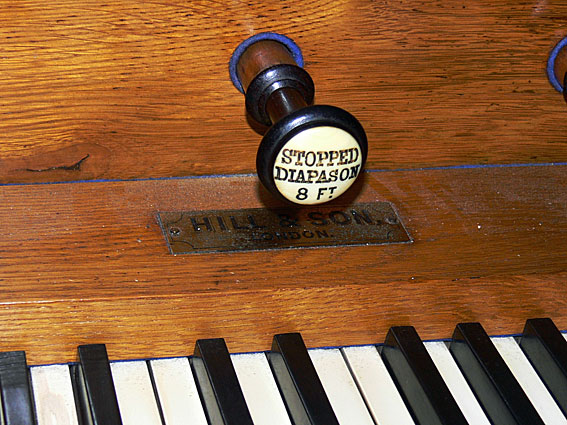
St Augustine's Catholic Church, Yarraville: exterior
[photograph by John Maidment (7 January 2010)]

Historical and Technical Documentation by John Maidment
© OHTA, 2010 (last updated November 2016)
On 1 February 1925 the new church of St Augustine at Yarraville was blessed and opened by Archbishop Daniel Mannix.1 The building, designed in a Romanesque style by T.A. Payne, of Moonee Ponds, has an impressive facade facing Somerville Road and a tower capped by a cupola of Spanish inspiration. The spacious interior focusses upon the sanctuary and side chapels, placed under three arches. A record of the opening mentions that 'a fine pipe organ is installed in the gallery'.2
The William Hill order book records the order of the organ on 28 October 1872.3 It was ordered by Wilkie & Co., Melbourne which was a firm of musical retailers. The instrument had the Hill & Son job number 1450. It appears that this instrument was ordered with a view to a future sale.
GT CC to f Op Dulc St Dia Pr Lieb ged 4
General swell to all but open
Deal case diap pipes
Packed + delivered docks £131.5.0
It was reported in a subsequent advertisement:
CHURCH ORGAN by HILL and SONS, Just received. 1 manual, 5 stops, open diapason, stopt diapason, dulciana, principal, lieblich gedact general swell, pipes decorated in colours and gold. Beautiful quality of tone. WILKIE, WEBSTER, and ALLAN, 16 Collins street east.4
A second advertisement recorded that this instrument was for sale at a price of £150.5
A 'fine new organ by Hill & Son of London, bought from Allan & Co' was installed in 1876 in the West Melbourne Independent Church. The organ was moved in September 1887 by George Fincham to the North Melbourne Town Hall and in May 1889 it was removed from the Town Hall and installed 'in the church'. It would seem highly likely that this was the Hill & Son ordered in 1872 by Wilkie & Co which was later known as Wilkie, Webster & Allan.6
A letter from George Fincham & Sons of 2 June 1921 records the tuning of the organ at the Independent Church Lonsdale Street West so it appears that the organ was located here until this date.7

St Augustine's Catholic Church, Yarraville: organ in gallery location 1966
[photograph by John Maidment (February 1966)]
The organ was opened a Yarraville in 1925 and placed to the right of the rear gallery facing diagonally down the building. It is not certain who installed the organ there.

St Augustine's Catholic Church, Yarraville: organ placed in side chapel
[photograph by John Maidment (7 January 2010)]
In 1970 the organ received a thorough restoration by George Fincham & Sons Pty Ltd. It was moved to the left chapel and was placed facing across the building. The action and pipework were carefully refurbished, the casework and console timbers were repolished, and the previously-stencilled facade pipes sprayed in gold paint. A small facade of six matching dummy pipes was placed to the left of the organ in place of former side panelling. By contemporary standards, this was an exemplary restoration, the only alterations consisting of the minor changes to the side case, repainting of internal wooden components in grey paint and the fitting of tuning slides. The feeders and hand blowing gear have also been removed from the double-rise reservoir, which has stone weights. The organ has served the church admirably for 90 years.8

St Augustine's Catholic Church, Yarraville: console detail
[photograph by John Maidment (7 January 2010)]
The instrument sounds well in a resonant acoustic and gives the impression of a far larger instrument. The console retains its scrolled sides, oak fittings, keyboard and flat pedal board, and distinctive drawstops and engraved brass nameplate, all of which are original. The facade pipes have Hill & Son's typical rounded upper and lower lips. It is interesting that while the 4ft flute is labelled Wald Flute 4, it is actually a 4ft Lieblich Flute, with stopped metal pipes, the stoppers made from turned wood. The Open Diapason 8ft is entirely unenclosed, with the pipework placed outside the swell box.
This is a charming small organ and one of the smallest examples of Hill & Son's work to be exported to Australia. The 1891 organ at St John's Anglican Church, Albany, WA is one stop larger while the practice organ at the residence of Dr Bill Ralph, Mornington, Vic is similar in size.
| MANUAL Open DiapasonFT Stopped DiapasonFT DulcianaFT PrincipalFT Wald FluteFT |
8FT unenclosed 8FT enclosed wood 8FT enclosed grooved bass 4FT enclosed 4FT enclosed stopped metal |
Compass: 56/29
Pedal pulldowns
Lever swell pedal
Mechanical key and stop action9
The organ was returned to the rear gallery of the church by Wakeley Pipe Organs Pty Ltd in 2010.

St Augustine's Catholic Church, Yarraville: view of interior looking to organ and altar
[photograph by John Maidment (7 January 2010)]

St Augustine's Catholic Church, Yarraville: detail of drawstop engraving and nameplate
[photograph by John Maidment (7 January 2010)]

St Augustine's Catholic Church, Yarraville: pipework detail
[photograph by John Maidment (7 January 2010)]

St Augustine's Catholic Church, Yarraville: action detail
[photograph by John Maidment (7 January 2010)]

St Augustine's Catholic Church, Yarraville: wind reservoir
[photograph by John Maidment (7 January 2010)]
1 Footscray Advertiser 31 January 1925, cited in St Augustine's Yarraville: a history of the church & school: compiled for reunion celebrations 19th – 20th October, 1985, edited by Mrs C.M. Taig
2 Footscray Advertiser, 31 January 1925
3 William Hill order book volume III (May 1872-July 1875) p.8, British Organ Archive, Birmingham http://www.ohta.org.au/resources/Hill-records/pdfs/1450%20Melbourne.pdf
4 The Argus, 19 March 1874, p.6
5 Ibid.
6 Victorian Independent, September 1876, cited in E.N. Matthews, Colonial Organs and Organbuilders (Carlton: Melbourne University Press, 1969), p.110
7 George Fincham & Sons letter books (held at the State Library of Victoria)
8 Details noted by John Maidment
9 Ibid.